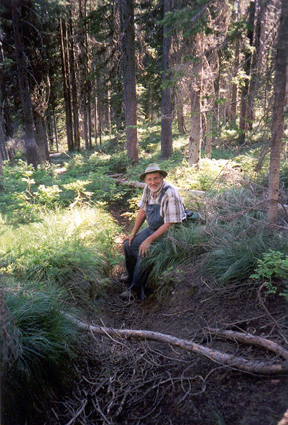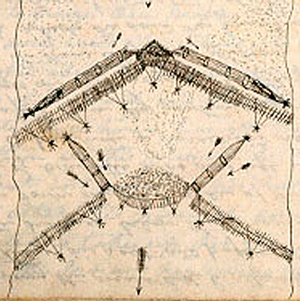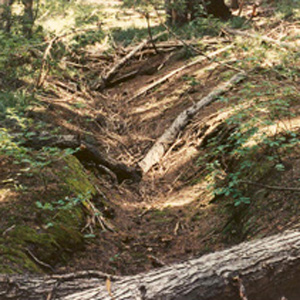Steve Russell on Bald Mountain

© 2001 Steve F. Russell.
Steve F. Russell is an electrical engineer on the faculty at Iowa State University. He was born in Lewiston, Idaho, and spent his youth at several locations along the Lewis and Clark trail. He has lived at Lochsa Lodge at Powell, Idaho, on the Weippe Prairie, and in the Bitterroot Valley of Montana. For two decades he has returned to Idaho and western Montana each summer to conduct intensive, systematic research on the locations of the actual trail treads and campsites used by the expedition. His methods include the study of old maps, early aerial photos, pioneer survey notes, National Archives records and, of course, the expedition’s journals. He has developed high-tech computer tools that apply mathematical analysis, geographic information systems and the Global Positioning system to analysis of all the courses and distances given in the journals. His approach is also unique among modern researchers in that he has actually found, hiked, and documented the exact trail tread followed by the expedition.
Steve’s work has won national acclaim for its accuracy and thoroughness. Other history-related projects have included a 1989 Lewis and Clark map study and map atlas for the Bitterroot Historical Society, and a Carroll Trail mapping publication for the Meagher County News, which in 1989 won a second-place award for Best Single Centennial Story in Montana newspapers. Steve is a popular speaker and workshop instructor. An archive of his research can be found at https://trailresearch.org/steve-f-russell.
Steve provided coordinates to Joseph Mussulman and Jim Wark to help the pilot locate areas to photograph in their work, Discovering Lewis & Clark from the Air, the full text of which is provided on this site (see Lewis & Clark by Air).
Contribution


Clark visits a Shoshone camp on the west bank of the Lemhi River near today’s Salmon City, where he and his men are fed on “Sammon boiled, and dried Choke Cher[rie]s,” and taken on a sight-seeing trip to the nearby permanent fishing weirs.


Imagine a time when all travel was on foot. This ancient time was the beginning of travel across the rugged Bitterroot Mountains for the Indian tribes of the northwest United States. This is a story of travel in those mountains from ancient times up to the present.
Experience the Lewis and Clark Trail
The Lewis and Clark Trail Experience—our sister site at lewisandclark.travel—connects the world to people and places on the Lewis and Clark Trail.
Discover More
- The Lewis and Clark Expedition: Day by Day by Gary E. Moulton (University of Nebraska Press, 2018). The story in prose, 14 May 1804–23 September 1806.
- The Lewis and Clark Journals: An American Epic of Discovery (abridged) by Gary E. Moulton (University of Nebraska Press, 2003). Selected journal excerpts, 14 May 1804–23 September 1806.
- The Lewis and Clark Journals. by Gary E. Moulton (University of Nebraska Press, 1983–2001). The complete story in 13 volumes.

